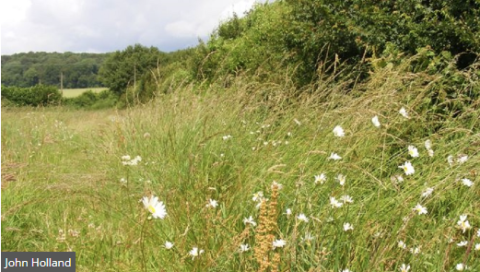Natural enemies, such as parasitoid species, are an important element in managing crop pests. By considering the SAFE approach (shelter, alternative prey, flower-rich habitat, environment), natural enemies can be encouraged and help to protect crops.
Database of insecticides and their effect on natural enemies
Using flowering seed mixes to improve farmland biodiversity
Management of beneficials (Agronomy Conference 2023 video)
Encourage natural enemies with the ‘SAFE’ approach
Natural enemies require appropriate resources to help keep pests in check.
S is for ‘shelter’
Hedgerows, associated margins and other shrubby areas are protected from insecticides and intensive tillage. Such habitats enable beneficial insects to repopulate nearby crops. Strips of tussocky grasses and flower-rich grassland support high densities of some species. Natural enemies that only live for part of the year within a crop need other habitats in which to forage, breed or survive dormant periods.
Provide shelter for natural enemies by:
- Managing hedges to create different structures with varied plant species
- Re-sowing any degraded hedge bases covered in noxious weeds (such as ragwort or thistles) with a flower-rich grass mix
- Protecting natural vegetation along hedge bases and fence lines from insecticide and herbicide drift
- Ploughing two furrows together to form a raised ‘beetle bank’ to create drier conditions favoured by insects and divide larger fields – sow with tussock-forming grasses
A is for ‘alternative prey’
Pests often occur sporadically during the growing season, with shorter life cycles than natural enemies. Other food sources (alternative prey) within and outside fields are needed to maintain natural enemy populations.
Food sources include:
- Other crops
- Uncropped areas, such as field margins, woodland, and less intensively managed grassland
- Under-sowing
- Weeds (uncompetitive)
- Minimum tillage
- Organic manures
Minimum tillage and application of organic manures are especially valuable for providing suitable conditions for detritus-feeding invertebrates that serve as alternative prey for predators.
F is for ‘flower-rich habitat’
Pollen and nectar are essential for some groups of natural enemies, especially parasitic wasps and hoverflies. They are important foods for many other natural enemies.
Woodlands, hedges, margins, crops, and agri-environment habitats containing wildflowers, annual arable plants or flowering wild bird seed plants can supply pollen and nectar. These flower-rich areas also support alternative prey.
Flower-rich areas can be created using a mix of wildflowers and grasses or legumes. Mixes that provide both complex and simple flowers are the most beneficial because these support both short- and long-tongued insects.
E is for ‘environment’
Insect natural enemies thrive in diverse vegetation that has not been treated with insecticides, such as field margins. All insecticides affect them to some degree, so it is important to minimise usage by adopting integrated pest management (IPM) practices. Other pesticides may adversely affect natural enemies, directly or indirectly, for example, removal of weedy habitats.
Correct management will help to create a habitat structure that provides natural enemies with cover and a suitable microclimate.
Ensure habitats are:
- Spread across the farm – some natural enemies tend to remain close to margins
- Diverse – to encourage a variety of natural enemies
Main natural enemy groups and key species
Beetles (Coleoptera)
Birds (various)
Bird identification (RSPB website)
Bugs (Hemiptera)
Flower and pirate bugs, damsel bugs and assassin bugs
Centipedes (Chilopoda)
Flies (Diptera)
Lacewings (Neuroptera)
Sawflies, wasps, ants and bees (Hymenoptera)
Sawflies, wasps, ants and bees
Parasitic wasps/parasitoids (various)
There are thousands of species of parasitoids. Most species are wasps, but there are also families of parasitoid flies and beetles.
Parasitic wasps/parasitoids (Apocrita/Parasitica)
Spiders and mites (Arachnida)
There are thousands of species of parasitoids. Most species are wasps, but there are also families of parasitoid flies and beetles.



